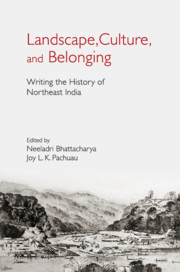Book contents
- Frontmatter
- Contents
- List of Figures
- Acknowledgements
- Introduction
- I Borders and Beyond
- 1 India's Spatial History in the Brahmaputra–Meghna River Basin
- 2 The Birth of the Ryot: Rethinking the Agrarian in British Assam
- 3 Embracing or Challenging the ‘Tribe’? Dilemmas in Reproducing Obligatory Pasts in Meghalaya
- II Surveys and Explorations
- III Ethnography, History, and the Politics of Representation
- IV Law, State, and Practices of Governance
- V Cultural Dialogues
- Notes on Contributors
- Index
1 - India's Spatial History in the Brahmaputra–Meghna River Basin
from I - Borders and Beyond
Published online by Cambridge University Press: 26 April 2019
- Frontmatter
- Contents
- List of Figures
- Acknowledgements
- Introduction
- I Borders and Beyond
- 1 India's Spatial History in the Brahmaputra–Meghna River Basin
- 2 The Birth of the Ryot: Rethinking the Agrarian in British Assam
- 3 Embracing or Challenging the ‘Tribe’? Dilemmas in Reproducing Obligatory Pasts in Meghalaya
- II Surveys and Explorations
- III Ethnography, History, and the Politics of Representation
- IV Law, State, and Practices of Governance
- V Cultural Dialogues
- Notes on Contributors
- Index
Summary
All the greatest rivers of monsoon Asia – the Indus, Ganga, Brahmaputra, Irrawaddy, Salween, Chao Phraya, Mekong, Yangtze, and Huang Ho – come to life atop the world, in Tibet's high mountains, cold, rocky, and dry, where scruffy nomads herd goats. The rivers descend through deep twisting valleys, gorging themselves on melting snow and monsoon rain from countless tributaries, and they finally settle down to wandering the lush green lowlands of ancient agrarian civilizations, joining the sea in the teeming hot deltaic heartlands of Asia's modern world economy. On the way down from the highlands, rivers change names and identities to mark their passage through the homelands of history, where nature's free-running waters acquire social life in geographies inscribed most powerfully by the great imperial civilizations that came to life in river lowlands, expanding their reach over centuries, upstream and downstream, across the plains, into the highlands. Many smaller, less powerful homelands also evolved in the pathways of imperial expansion, and interactions among all these societies, in their different habitats, produced a vast diversity of connected communities, which collectively entered the historical record ‘during the first millennium CE, [when] nascent centers of … civilization were part of an interacting continuum of communities that occupied, thickly or thinly, the whole of South Asia’. As Sumit Guha goes on to explain,
The differentiation that began to occur was socio-cultural as well as technological, and the communities of the riverain plains, the forest, the savanna, the desert and the high mountains co-evolved in continuous interaction involving both conflict and cooperation over the next two millennia. Each community's habitat was a resource for it: a resource defined not merely in economic, but in political and cultural terms. The boundaries and aspirations of communities were defined by the presence of other communities, other ways of living – identities generated by contrasts; and one of the most crucial of these contrasts was between the civilized and their domesticated landscape, and the savages in their wild woods.
Over the past two millennia, imperial state territorialism, spreading out from the lowlands, has defined Asia's historical geography. Forest, jungle, mountain, desert, river, ocean, and savannah became peripheral, exotic habitats for people outside core regions of imperial culture filled with intensive farming, commerce, arts, manufacturing, urbanity, and spatial order, where progress meant imposing their imperial design on their surrounding environment.
- Type
- Chapter
- Information
- Landscape, Culture, and BelongingWriting the History of Northeast India, pp. 23 - 37Publisher: Cambridge University PressPrint publication year: 2019



